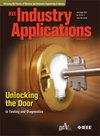高速重载电动汽车牵引电机250 kW连续运行绞合绕组与发夹绕组的比较研究
IF 4.5
2区 工程技术
Q2 ENGINEERING, ELECTRICAL & ELECTRONIC
引用次数: 0
摘要
发夹绕组作为提高牵引电机功率密度和效率的关键技术,在乘用电动汽车中得到了广泛的应用。同时,发夹绕组在商用电动汽车上的优势和挑战尚未得到充分的研究。本文对随机绞合绕组和发夹绕组进行了临界比较,为半卡车重型牵引力的设计提供了指导和见解。基于550Nm的峰值扭矩和12000 rpm的峰值速度性能要求,设计参数包括槽极组合,整体几何形状,导体尺寸和布局以及冷却策略进行了评估。从多物理场域优化工具中选择不同绕组配置的代表性设计案例,详细研究了发夹绕组解决方案在功率密度、功率损耗和热管理方面的差异。对于发夹绕组,还研究了在一个槽中可变导体尺寸的选择。比较结果表明,重型应用将推动发夹绕组解决方案向更高的每极每相槽数(q)发展,以实现更平衡的功率损耗分布。这种平衡的损失分布进一步简化了冷却策略,使其无需采用更复杂的轴冷却系统。在优化设计的基础上,分别制造了72槽8极绞线绕组和96槽8极发夹绕组两种样机并进行了测试,结果表明,发夹绕组方案在降低绕组和磁体温升的情况下,连续功率密度提高了22%。本文章由计算机程序翻译,如有差异,请以英文原文为准。
Comparative Study of Stranded and Hairpin Windings for 250 kW Continuous Operation of High-Speed Heavy-Duty EV Traction Motor
Hairpin winding has been widely applied in passenger electrical vehicle (EV) industry, as a key technology brick that enables step-change improvements on power density and efficiency of traction motors. Meanwhile, the advantages and challenges of hairpin windings are yet to be fully investigated for commercial EV applications. This paper deals with critical comparison between randomly stranded and hairpin windings, to provide design guideline & insight for semi-truck purposed heavy-duty traction. Based on 550Nm peak torque and 12000 rpm peak speed performance requirements, design parameters including slot-pole combinations, global geometry, conductor sizes & layouts as well as cooling strategies are evaluated. Represented design cases with different winding configurations down-selected from multi-physics domain optimization tool, are looked into in detail to quantitatively highlight the differences hairpin winding solutions can bring in power density, power losses, and thermal management. For hairpin windings, the options of variable conductor sizes in one slot are also investigated. The comparison results reveal that heavy duty applications will push hairpin winding solutions towards higher number of slots-per-pole-per-phase (q) for more balanced power loss distributions. This balanced loss distribution further simplifies the cooling strategy, making it unnecessary to employ more complex shaft cooling systems. Based on optimised designs, two prototypes with 72-slot, 8-pole stranded winding and 96-slot, 8-pole hairpin winding, respectively are manufactured and tested, which shows that the hairpin winding solution can provide 22% improvement in continuous power density at reduced temperature rise on both windings and magnets.
求助全文
通过发布文献求助,成功后即可免费获取论文全文。
去求助
来源期刊

IEEE Transactions on Industry Applications
工程技术-工程:电子与电气
CiteScore
9.90
自引率
9.10%
发文量
747
审稿时长
3.3 months
期刊介绍:
The scope of the IEEE Transactions on Industry Applications includes all scope items of the IEEE Industry Applications Society, that is, the advancement of the theory and practice of electrical and electronic engineering in the development, design, manufacture, and application of electrical systems, apparatus, devices, and controls to the processes and equipment of industry and commerce; the promotion of safe, reliable, and economic installations; industry leadership in energy conservation and environmental, health, and safety issues; the creation of voluntary engineering standards and recommended practices; and the professional development of its membership.
 求助内容:
求助内容: 应助结果提醒方式:
应助结果提醒方式:


